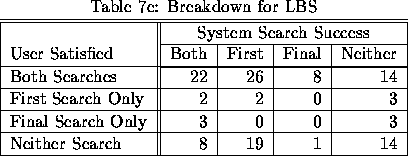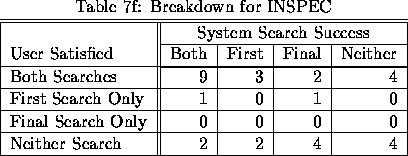




Table 7a summarises users' perception of the success of their queries, based on the two questions (described in 5.2.4 above) about whether they were ``largely satisfied'' or ``largely dissatisfied'' with their search. The figures in brackets express each combination of answers as a percentage of the total queries. Only those who had used the expanded search option were asked the second question. 202 LBS users and 37 INSPEC users left the system without answering the questions --- one user answered the first question, but not the second. In cases where both questions were answered, there is quite a close correspondence between the perceptions of initial and final success. LBS users recorded higher satisfaction levels than INSPEC users.

Table 7b contains a breakdown based on system measures of success, i.e. whether one or more relevant documents was found in a) the initial search and b) one or more expanded searches. (There are a small number of queries unaccounted for in this table, but the proportions in each category are sufficiently accurate for the current analysis.) Not surprisingly there are rather few instances where initial failure was followed by later success --- maybe it is interesting that there were any at all.

The following tables attempt to relate the user and system measures of success. Table 7c considers only queries which were not expanded, so the figures are based only on the first search. Correlation between the two measures does not appear to be very high. Perhaps the most striking figures are for users who professed satisfaction with their search, but had not selected any relevant documents.

Tables 7d considers only expanded queries, for which users answered both questions about search satisfaction. A satisfaction or success is now counted if it was recorded for either or both the initial results. The largest proportion of queries at both sites registered a success according to both user and system measures.

Finally, the same information is presented with first and final searches differentiated. The intersection sets are now very small indeed --- these tables are really provided to show how the totals in Table 7d were arrived at.





